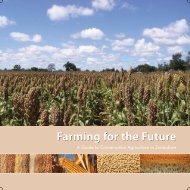Restoring the Soil - Canadian Foodgrains Bank
Restoring the Soil - Canadian Foodgrains Bank
Restoring the Soil - Canadian Foodgrains Bank
Create successful ePaper yourself
Turn your PDF publications into a flip-book with our unique Google optimized e-Paper software.
Green Manure/Cover Crop Systems67BrazilEPAGRI, <strong>the</strong> agricultural development arm of <strong>the</strong> state government of Santa Catarinain Brazil, has introduced well over a hundred gm/cc systems, using over 70 gm/cc species,in <strong>the</strong> state. Many of <strong>the</strong>se systems, and some o<strong>the</strong>rs, have also been introducedinto huge areas of Parana, Rio Grande do Sul and o<strong>the</strong>r Brazilian states, to a sum totalof well over a million farmers. I have personally observed <strong>the</strong> handful of systems listedbelow, but <strong>the</strong>y are only <strong>the</strong> tip of a very large iceberg.41. Brazil. Brazilian farmers use gm/ccs, amongo<strong>the</strong>r things, to be able to increase <strong>the</strong> organicmatter in <strong>the</strong>ir soils as rapidly as possible, so <strong>the</strong>ycan begin using zero tillage within a year or two.Therefore, gm/ccs like this crotalaria, that wasintercropped with maize, are very popular, because<strong>the</strong>y commonly produce a total biomass of wellover 80 t/ha (green weight).S44 to S46. Maize/crotalaria. At least threespecies of <strong>the</strong> genus Crotalaria are used asintercrops with maize in Santa CatarinaState (Photo 41). The crotalarias are generallyplanted at <strong>the</strong> same time as <strong>the</strong> maize.In Brazil, all of <strong>the</strong>se systems includingthose using o<strong>the</strong>r intercrops such as forageturnips, jackbeans and oats (<strong>the</strong> latter notincluded here because <strong>the</strong>y are not leguminous)are designed not so much to providenutrients to <strong>the</strong> soil as to produce largequantities of organic matter. Farmers use<strong>the</strong> systems so <strong>the</strong>y can increase <strong>the</strong>ir soilorganic matter content enough to move tozero tillage as quickly as possible. Over 25million ha of land in Brazil and Argentinaare now in zero tillage. 24S47. Fruit/mucuna. Mucuna is used as a cover crop under various species of fruit treesin Acre State. Perennial peanut would probably be a better choice of cover crop, toreduce <strong>the</strong> labor of cutting <strong>the</strong> mucuna out of <strong>the</strong> trees and of reseeding <strong>the</strong> mucunaeach year.S48. Onions/mucuna. Mucuna is used in a rotation for onion production in SantaCatarina. Hundreds of farmers use this system introduced by EPAGRI.S49. Various crops/common peas. For a number of different crops, peas are grown asa winter rotation crop in Santa Catarina, both as a gm/cc and as a cash crop.Hundreds, if not thousands, of farmers use this traditional system.24Brown, Lester R., World on <strong>the</strong> Edge, How to Prevent Environmental and Economic Collapse (New York: Earth PolicyInstitute, 2011), pp. 143-44.
















